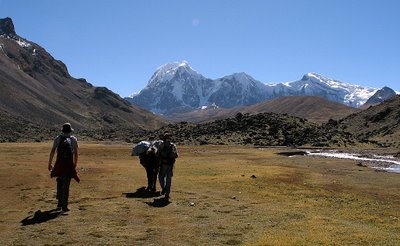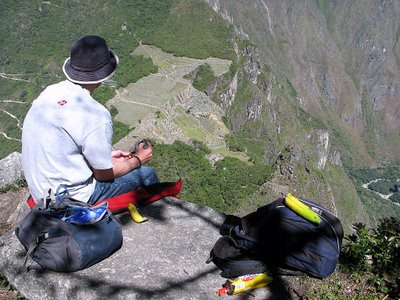Lynne says...
Ausangate is the highest mountain in Southern Peru (6362m)and revered by locals and trekkers alike. The Ausangate Circuit trek predictably encircles the mountain and is normally completed in six days and five nights. I knew it would be a challenge but it was one I was willing to take on. A combination of high altitude and extremes of temperature made it a forboding prospect for a fair weather camper such as myself but I am all for a taking on a personal challenge and so I was thrilled yet nevous at the thought of what lay ahead.
The trip to the village of Tinqui, the start of the trek, was an experience in itself. We were crammed on to a bus belching exhaust fumes and packed full of locals with all their baggage. In front of us two young women started bagging up dozens of pieces of fruit and a bread rolls and I soon found out why.
Three hours into our journey we stopped at a police checkpoint in a village and out of nowhere several dozen women and children appeared at the side of the bus, arms outstretched and shouting "Para mi" or "Da me". The two women opened the window and started throwing out the bags of fruit and bread. I was surprised at what I was witnessing. I had not seen anything like this before in Bolivia or Peru and I had not expectected it here. Women held up toddlers to grasp for the bags of food, jostling each other to get closer to the window.
As the bus pulled away the handouts continued. The dusty road was lined with ragged children running alongside the bus and holding out their hands shouting "Para mi, para mi". The women continued to throw out the bags of food. I started to wonder whether or not this was some kind of game. Although the children were dirty and scruffy, they didn't look as if they were starving. The two women kept giggling to each other as if they were enjoying the spectacle which gave the impression that the food was not desperately needed.
 Luxury all mod cons accommodation at Hostal Tinqui
Luxury all mod cons accommodation at Hostal TinquiWe arrived in Tinqui several uncomfortable hours later and were greeted by Teo, our guide for the next six days. We have never used a guide and a pack horse to carry our gear before. On our previous treks we have always managed perfectly fine navigating ourselves and carrying our own gear (or I should say that Matt carries most of the gear and I get away with carrying a small daysack).
For this particular trek we had been advised to employ a guide due to local resentment at foreigners walking through their land yet not contributing anything to the community - previous independent trekkers had been robbed and I didn't fancy this prospect at high altitude in the middle of nowhere. Matt was reluctant but I was pleased that A) we wouldn't get lost and B) Matt would be able to enjoy the trek without carrying his body weight in kit.
The next five nights and six days proved to be as challenging as I had predicted. I have never experienced such extremes of temperature. During the day we walked in short sleeves and needed hats and lotion to protect us from the sun. At night we slept in freezing temperatures. Every morning the inside of the tent was covered in ice and the ground outside covered in frost.
Our first day of walking was relatively easy and we had set up camp by early afternoon. We had the luxury of a hot pool all to ourselves with fantastic views of Ausangate. We then experienced our first night of freezing temperatures and an ice covered tent and from then on the trek grew tougher.
 I know what, let's go to South America. It'll be really hot there....
I know what, let's go to South America. It'll be really hot there....It is difficult to relate just how uncomfortable the nights were. After a dinner of noodles, hot cocoa and biscuits we were always firmly esconced in our sleeping bags by 6pm when darkness fell. We probably slept for a few hours and then a combination of the cold and our hip bones digging into the ground made us wake up. We slept on and off for the rest of the night, tossing and turning and shifting postions, desperate for a bit of comfort.
As it slowly grew light outside we concentrating on staying warm before braving the cold at around 6.30am. We quickly fell into a routine. Matt would start boiling water for our breakfast of porridge and I would sort out the tent - packing up our clothes, sleeping bags and roll mats. We would take off the fly sheet of the tent and lay it in the sun to melt the ice.
 Lynne packs the sleeping bags away on another freezing morning
Lynne packs the sleeping bags away on another freezing morningThe three of us would then sit in the increasingly warm sun, eating our Quaker oats and generally defrosting. The minute the sun appeared we would feel its warmth and within minutes the ice and frost would disappear and we would start peeling off our layers.
 This is not a wind-up. You had to sleep like this to feel anywhere near warm
This is not a wind-up. You had to sleep like this to feel anywhere near warm For the first two days we walked towards Ausangate. The further we walked from Tinqui, the fewer adobe houses we encountered until we were almost completely alone. It was a strange feeling to know we were several days walk from the nearest telephone or professional medical assistance.
The further we walked, the more spectacular the scenery became. The first of five mountain passes took us to a breathtaking 4650 m and for every night of the trek we would barely dip below this. Each day we saw a variety of wildlife from the common alpaca and llama to the much harder to spot vicunas and viscachas (rabbit-like creatures).
 Not a bad view for a toilet stop
Not a bad view for a toilet stopOn night three we camped in an isolated valley close to a lake below an imposing glacier. While the sun was still up Teo approached us in a slightly apprehensive manner and asked if we'd like to eat fresh trout in the morning and if so, could we help him out for half an hour after dark. We were about to get a lesson in fish poaching - and I'm not talking about the water-in-a-pan variety!. With only the moon and our headtorches to guide us we helped Teo use a combination of plastic bottles, string, netting and stones to lay a trap for our breakfast in the glacial lake. As it was dark we had no real idea what Teo was doing, we simply followed his shouted instructions from the other side of the lake. It felt slightly illicit and dangerous yet completely exciting.
The next morning we were greeted with Teo and eight fresh trout. Matt steamed them with a little salt for breakfast and it made a delicious change to our Quaker oats.
 Lynne at the top of the 5050m Jampa pass with the 5670m mountain Puca Punta in the background
Lynne at the top of the 5050m Jampa pass with the 5670m mountain Puca Punta in the backgroundWe climbed to our highest point of the trek on Day Four - the Campo Pass took us to 5068m. It took an absolute age to climb. At one point I was desperate for air - my lungs struggling to cope with the exertion. The bizarre consequence of trekking at altitude is that every step can be laborous and you are completely out of breath yet within seconds of stopping for a rest you feel perfectly fine.
 Matt and Teo walk up the Jampa valley with Pico Tres in the distance
Matt and Teo walk up the Jampa valley with Pico Tres in the distanceAs we climbed above the snowline, each step took me closer to the top and the fantastic views that I knew were awaiting me. Matt and Teo were already there, resting and gazing out at the view. Previous trekkers and locals alike had built several dozen cairns. The local Quechans build them for Pachamama - Earth Mother - and always leave a small offering of food for good luck and to ward off evil spirits. We did the same - although selfishly left some grim peanuts rather than our tast fruit pastilles!
Further down the valley we could again see the peak of Ausangate and it beckoned me. Experienced mountaineers start the ascent at midnight and generally arrive by 9am. The views must be stunning and for the first time I actually started to consider such an attempt in the future. Maybe it was just the brilliant white snow and bright blue sky that was lulling me into a false sense of how easy it would be.
By day five we had trekked around Ausangate itself and now its magnificent peak lay behind us. We arrived at the community of Pacchanta at around 11am and set up camp in the garden of Teo's brother-in-law. We were treated to a steamy hot pool once again and we soaked in its warmth for a few hours, enjoying the view of Ausangate in the distance.
 Lynne relaxes in the thermal pool at Pacchanta on the final afternoon
Lynne relaxes in the thermal pool at Pacchanta on the final afternoonA local lady in traditional dress approached our tent as we sat enjoying the sun and laid out her wares. She was selling traditional weavings, alpaca scarves, tiny bags and intricate beaded headresses used during festivals. I knelt in front of them and sorted through everything, trying to decide what to buy. I was glad to have the opportunity to buy directly from a local woman instead of through a middle man in Cusco. The prices would also be much more reasonable and I was safe in the knowledge that all the money would go directly to her.
 Undeniable proof that women can find things to buy ANYWHERE
Undeniable proof that women can find things to buy ANYWHEREI decided on four items all of which had belonged to her mother and were over thirty years old. I did feel slightly guilty that I was buying such family items but I guess the money will be much more useful to her.
Our final night was just as cold as all the rest even though we were at a slightly lower altitude. The next morning, after our customary early start and bowl of steaming oats, we walked for a further four hours until we reached Tinqui.
As we waited for our transport back to Cusco we sat and watched as men and women in colourful clothes went about their daily business. I was completely absorbed by it. Teo introduced us to his wife and we sat next to each other. She was spinning alpaca wool and she showed me how it was done.
 Local ladies in traditional dress on Tinqui´s main street
Local ladies in traditional dress on Tinqui´s main streetMy sense of achievement was immense. We had successfully circumnavigated the highest mountain in southern Peru and survived freezing night time temperatures. During the days we experienced spectacular views and encountered isolated communities that continue with their traditional way of life, undisturbed by the outside world. The Ausangate Circuit is a challenge but one that is completely worthwhile.



























